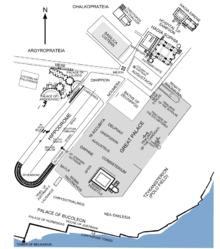|
TzykanisterionThe tzykanisterion (Greek: τζυκανιστήριον) was a stadium for playing the tzykanion (τζυκάνιον, the Greek name for Chovgan, from Middle Persian čaukān, čōkān), a kind of polo adopted by the Byzantines from Sassanid Persia.[1] HistoryAccording to John Kinnamos (263.17–264.11), the tzykanion was played by two teams on horseback, equipped with long sticks topped by nets, with which they tried to push an apple-sized leather ball into the opposite team's goal.[2] The sport was very popular among the Byzantine nobility: Emperor Basil I (r. 867–886) excelled at it; his son, Emperor Alexander (r. 912–913), died from exhaustion while playing, Emperor Alexios I Komnenos (r. 1081–1118) was injured while playing with Tatikios, and John I of Trebizond (r. 1235–1238) died from an injury during a game.[2][3]  The Great Palace of Constantinople featured a tzykanisterion, first built by Emperor Theodosius II (r. 408–450) on the southeastern part of the palace precinct. It was demolished by Basil I in order to erect the Nea Ekklesia church in its place, and rebuilt in larger size further east, connected to the Nea with two galleries.[4] Aside from Constantinople and Trebizond, other Byzantine cities also featured tzykanisteria, most notably Lacedaemonia, Ephesus, and Athens, something which modern scholars interpret as an indication of a thriving urban aristocracy.[5] These were also used as places of public tortures and executions, as it is historically recorded for the tzykanisteria of Constantinople and Ephesus.[6] References
Sources
|